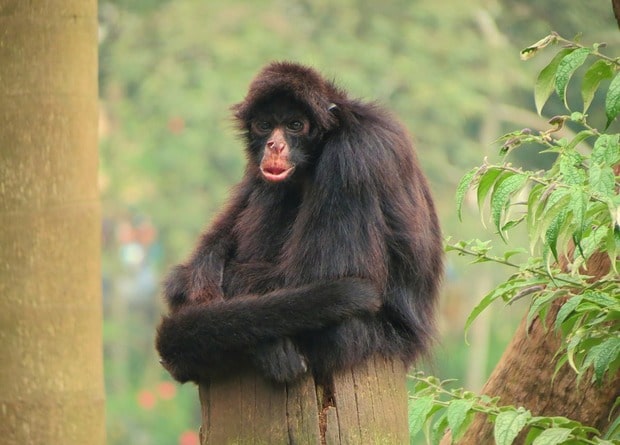Spider monkeys prefer fruits affected by insects, Brazilian and American scientists have found out. Eating fruits along with larvae, monkeys compensate for the lack of protein in the diet. Previous studies have shown that koats get protein from ficus fruits, inside which pollinating wasp larvae develop. However, where these trees are rare or do not grow at all, the monkeys have to make do with wormy fruits. The results of the study were published in an article for the International Journal of Primatology.
Monkeys from the genus Ateles, common in Central and South America, feed almost exclusively on ripe sweet fruits. Such a diet is rich in carbohydrates and fats, but it lacks protein. It is assumed that koats compensate for their deficiency by eating young leaves, shoots and buds or fruits with a high protein content. And Peruvian coats (Ateles chamek) from some populations get proteins from ripe fruits of ficuses (Ficus), in which larvae and wingless males of wasps from the Agaonidae family – pollinators of these plants (as well as parasitoid larvae developing in them) hide.
However, pollinating wasps are not the only insects found inside fruits. The pulp of the fruit feeds on the larvae of many Hymenoptera, Lepidoptera, flies and beetles. Most ripe fruits in tropical forests are affected by one or another larvae, and it is not uncommon to find representatives of several insect species in one fruit at once. By choosing the most wormy fruits and eating them along with the larvae, the koats could thus obtain a deficient protein. This strategy would be beneficial, at least in those regions of the Amazon where ficuses are rare. A similar strategy has already been recorded in related primates from the subfamily Pitheciinae – uakari and saki. They feed on immature seeds and, in order to compensate for the lack of protein, they try to choose those that are most affected by larvae.
A team of zoologists led by Adrian A. Barnett of the National Amazonian Institute decided to test whether koats actually prefer wormy fruits. To do this, the researchers went to the region of the middle reaches of the Tapajos River in the Brazilian state of Para. They chose two sites where ficuses are rare: one on the edge of a seasonally flooded forest, and the second in a forest that never floods. Here, the authors observed two species of coats: Peruvian and barnacles (A. marginatus). The former live to the west of the Tapajos River, and the latter to the east.
Barnett and his colleagues found feeding Peruvian spider monkeys in the forest and collected fresh fruit samples that they had not eaten and dropped down from the trees. The researchers also included in the sample fruits that they themselves cut from trees along with branches. Then the authors identified the species of all fruits and the larvae found inside them.
In total, the researchers analyzed 2,836 fruits from 74 trees belonging to 27 species. The larvae of beetles, flies and lepidoptera affected fruits of 23 species, which corresponds to 85 percent. 11 percent of larval species were found in 35–78 percent of fruits. Comparing the proportion of diseased specimens between fruit fed by koats and fruit hanging on a branch, the authors found that the monkeys selected the most wormy fruit from 12 of the 20 tree species for which they were able to collect multiple specimens.
However, in the case of four more species of monkeys, on the contrary, they tried to eat fruits untouched by insects. It is possible that in these plants the presence of larvae in the fruits provokes a defensive reaction and the release of unpleasant or toxic substances. In the case of four more species, the fruits of which showed the highest and lowest infestation with larvae, they did not show clear preferences. The authors suggest that it does not make sense for monkeys to look for the most wormy fruits of these species, since they are too common or too rare, respectively.
Apparently, spider monkeys usually compensate for the lack of protein by eating ficus fruits. However, where these trees are scarce or non-existent, monkeys have to eat the most wormy fruits. These may not be the only sources of protein for coats. Barnett et al. suggest that monkeys also eat insects that hide in young shoots and leaves and swallow aquatic insect larvae when they drink from bromeliad rosettes and leaf axils.
Earlier we talked about how Geoffroy’s coat (A. geoffroyi), spider monkeys from Central America, are looking for fruits. Zoologists have found that these primates form subgroups whose size adjusts to the number of fruiting trees. At the same time, they are guided not only by their own considerations, but also by the behavior of their relatives. This strategy allows you to efficiently find food in changing conditions.
Photo: Peruvian Ateles chamek












